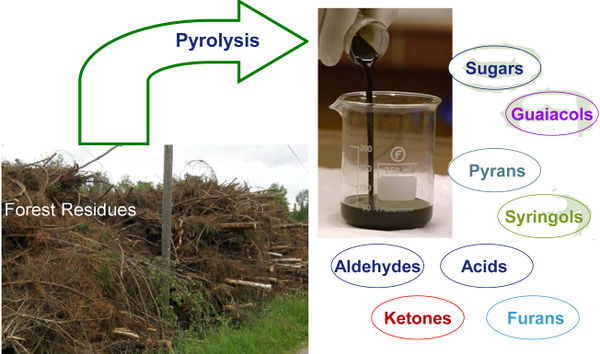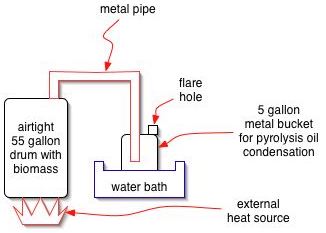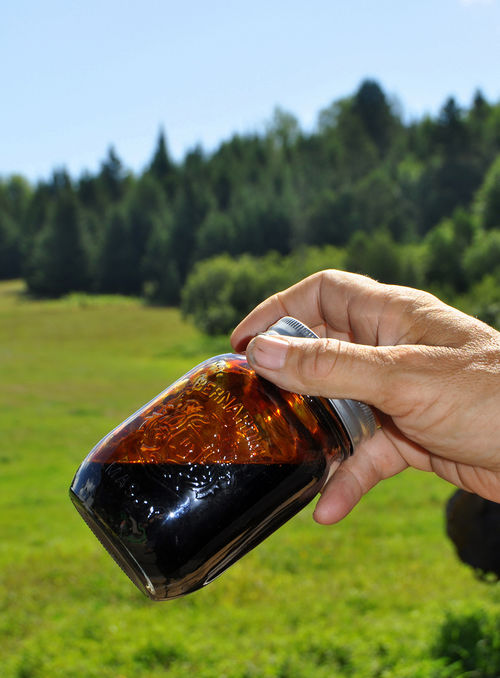Biochemicals from Pyrolysis: Difference between revisions
m (Included links to Alcohol book, included page within Pyrolysis Oil category) |
(Updated the page to the more recent formatting style) |
||
| (48 intermediate revisions by 4 users not shown) | |||
| Line 1: | Line 1: | ||
[[File:Biochemicals from Pyrolysis.jpg|600px|thumb|right|courtesy: Wytze Meindersma, Eindhoven University of Technology, found [https://noppa.tkk.fi/noppa/kurssi/ke-40.9920/luennot/KE-40_9920_extraction_of_chemicals_from_po.pdf here]]] | |||
=Overview= | |||
Liquids derived from the pyrolysis of biomass, also known as [[Pyrolysis_Oil|bio-oil]], may contain hundreds of different organic chemical substances. Some of these can be quite valuable (example: 100g levoglucosan = $200) and therefore using the vapors and liquids only for energy (example: burning in a [[Babington_Burner|Babington Burner]]) appears wasteful at first. Depending on the amount of gases/bio-oil produced, it may be worthwhile to separate out the complex organic chemicals from simpler ones. However, this may require a lot of effort and/or expense. | |||
==Components== | |||
The spectrum of chemicals varies with feedstock composition and pyrolysis conditions, such as gasifier temperature, rate of temperature increase, duration, pressure etc. | |||
[[File:Pyroil.jpg|326px|thumb|right|The vapors that come off can be sent into another drum, submerged in cool water for condensation to occur. ]] | |||
Other components include: | |||
*organic acids (formic acid, [[acetic acid]], propionic acid, butyric acid, etc); | |||
*phenol group; | |||
*carbonyl group (formaldehyde, acetaldehyde, etc.); | |||
*alcohol ([[ethanol]], methanol, etc); | |||
*neutral materials (levoglucosan, acetol, maltol, etc); | |||
*base (substances like ammonia, methylamine, dimethylamine, etc.) | |||
One major component from the dry distillation of wood is [http://en.wikipedia.org/wiki/Acetic_acid acetic acid], which has many applications and can even be used as an [[Vinegar_as_herbicide|organic herbicide]]. [[Methanol]] is another useful and frequent component. Upgrading of methanol to biodiesel (see: [[DME]]) is possible but may not be practical or even necessary ([[methanol]] IC engines are already widely used). | |||
After pyrolysis, the vapors are first cooled down for distillation. Water or external air may be used as coolants. Gaseous components (primarily carbon monoxide, hydrogen and [[methane]]) remain gases and can be flared. The liquid phase is then diluted with water, which leads to separation into a polar/aqueous and apolar/oily layer. Simple, low-tech, open-source methods of separation are needed (see below, "protocol"). | |||
==Is extraction worth the trouble ?== | |||
The alternative to extraction is always to use these substances for their energy content, in other words, burn the bio-oil. So rather than extract the apolar biochemicals from the oily phase, it may make more sense to mix all or some of them with [[Biodiesel|(bio-)diesel]] (see [[Bio-Oil_/_Diesel_Mixture_Fuels|this page]] for more details; and reference: [http://canmetenergy-canmetenergie.nrcan-rncan.gc.ca/eng/industrial_processes/industrial_energy_systems/publications/200855.html]). Similarly, if it is not worth extracting the sugars from the aqueous phase, they can possibly be fed into an alcoholic fermentation stream, producing ethanol, or into an anaerobic fermenter to make [[biogas]]. Unfortunately, many microbes are very sensitive to the contaminants in bio-oil. The acidity is also a problem but that can be fixed with buffering. | |||
[[File:Bio-oil farm.jpg|500px|thumb|right|Bio-oil ("biocrude") straight from the farm.]] | |||
==Syngas Fermentation== | |||
An interesting new development are biological methods for the catalysis of CO and H to ethanol. This is one application of the emerging field of [[Syngas Fermentation]]. Companies such as [http://www.coskata.com/ Coskata] and [http://www.enerkem.com Enerkem] are turning the various syngas components into ethanol using microbes in a bioreactor. Unfortunately, there are many patents in this field. | |||
==Possible Applications== | ==Possible Applications== | ||
* | * the classic: wood preservative [http://dx.doi.org/10.1016/j.wasman.2006.07.011] | ||
* organic acids (e.g. formic acid, [[acetic acid]]) | |||
* sugars, flavors | |||
* pharmaceuticals | |||
* bioplastics | |||
* | * fibers, resins, dyes, adhesives | ||
* | |||
==Possible Feedstocks== | ==Possible Feedstocks== | ||
* various kinds of biomass (corn stalks, straw, wood, leaf litter, algae) | * various kinds of biomass (corn stalks, straw, wood, leaf litter, algae) | ||
* manure incl. [http://www.humanurehandbook.com/ humanure] | * manure, incl. [http://www.humanurehandbook.com/ humanure] | ||
* animal waste, bones | * animal waste, bones | ||
==Important | ==Important considerations== | ||
* | * The question is: can this be scaled down to village scale in a practical way ? If so, the products (incl. [[Biochar|biochar]] from pyrolysis) may become important sources of revenue for the community. Being able to create a large number of different potential products with a ''single'' separation mechanism would be significant in terms of autonomy and resilience. | ||
* which feedstocks produce which biochemicals in reasonable quantity ? | * which feedstocks produce which biochemicals in reasonable quantity ? under what pyrolysis conditions ? | ||
* gasifier design / pyrolysis conditons etc. | * [[Gasifier|gasifier]] design / pyrolysis conditons etc. | ||
* distillation and separation of products; one extraction method is using methanol as a solvent [http://cat.inist.fr/?aModele=afficheN&cpsidt=13769264] | * distillation and separation of products; one extraction method is using methanol as a solvent [http://cat.inist.fr/?aModele=afficheN&cpsidt=13769264] | ||
* further processing of products | * further processing of products: when used for energy, purity may be less important then when used for pharmaceuticals (for example). | ||
==Possible OSE Protocol (under development and up for debate) == | |||
The goal here is to develop a simple, robust, low-cost, low-energy, (low-tech ?) way to extract certain biochemicals from biocrude. The process really already starts at the time of pyrolysis, since its conditions have major effects on the composition of the resulting bio-oil. Differences in the thermo-chemical stability of the main biomass constituents (cellulose, hemicellulose, lignin) can be used to selectively devolatilise their pyrolytic breakdown products ("[[staged pyrolysis]]"). Abundant solar process heat may be available and can be used for distillation and other steps, but that is a whole other topic. | |||
1.) Cool the pyrolysis vapors by running them through a coil which is immersed in coolant water. Which material to use for the coil ? perhaps copper ? glass ? clay pottery ? ... not steel, as the vapors are highly corrosive. This will separate out the gaseous components, namely CO, H2, CO2 and some CH4 from the liquid. Use these gases for energy (heat) to keep the reaction going, perhaps also to boil water and generate steam. Consider a heat recovery system that will later use this coolant water in a steam engine (after further heating and boiling) <br> | |||
2.) Dilute the resulting liquid portion with water and let settle - this separates the polar aqueous phase from the apolar oily phase; filtration will be required. The aqueous phase has some highly acidic components, such as formic acid and acetic acid. Let it settle, this step takes a bit of time. There are still volatiles in the liquid which evaporate over time (this has environmental, energy yield and health implications).<br> | |||
3.) So far, so good, but then it gets more complicated (depending on the bio-oil composition, goals of extraction, etc.). The apolar/oily phase has lighter and heavier components - and is therefore possibly amenable to [http://en.wikipedia.org/wiki/Fractional_distillation fractional distillation], for which an open source model could be developed. <br> | |||
== | ==Relevant Expired Patents== | ||
* | * [http://www.google.com/patents?id=rAhrAAAAEBAJ&printsec=abstract&zoom=4&source=gbs_overview_r&cad=0#v=onepage&q&f=false Levoglucosan production by pyrolysis of pretreated starches] | ||
* [http://www.google.com/patents/about?id=ccYPAAAAEBAJ Method and apparatus for converting solid organic material to fuel oil and gas] | |||
* | |||
=Internal Links= | |||
* [[Biofuels]] | |||
* [[Pyrolysis]] | |||
* [[Bioasphalt]] | |||
==External Links== | |||
* good introduction: [http://www.worldbiofuelsmarkets.com/downloads/presentations/16thMarch/Biorefineries/Paul_Wild.pdf "Innovative thermochemical conversion of biomas for value-added chemicals"] (Paul de Wild, [http://www.ecn.nl/home/ Energy Research Center of the Netherlands], Amsterdam) | |||
* excellent, detailed presentation: [https://noppa.tkk.fi/noppa/kurssi/ke-40.9920/luennot/KE-40_9920_extraction_of_chemicals_from_po.pdf "Separation of chemicals from pyrolysis oil"] by Wytze Meindersma, Eindhoven University of Technology, part of [http://www.biocoup.com/ "Biocoup" - Co-processing of upgraded bio-liquids in standard refinery units] | |||
[[Category: | [[Category: Bio-Petrochemistry]] [[Category: Materials]] | ||
Latest revision as of 20:34, 10 November 2020

Overview
Liquids derived from the pyrolysis of biomass, also known as bio-oil, may contain hundreds of different organic chemical substances. Some of these can be quite valuable (example: 100g levoglucosan = $200) and therefore using the vapors and liquids only for energy (example: burning in a Babington Burner) appears wasteful at first. Depending on the amount of gases/bio-oil produced, it may be worthwhile to separate out the complex organic chemicals from simpler ones. However, this may require a lot of effort and/or expense.
Components
The spectrum of chemicals varies with feedstock composition and pyrolysis conditions, such as gasifier temperature, rate of temperature increase, duration, pressure etc.
Other components include:
- organic acids (formic acid, acetic acid, propionic acid, butyric acid, etc);
- phenol group;
- carbonyl group (formaldehyde, acetaldehyde, etc.);
- alcohol (ethanol, methanol, etc);
- neutral materials (levoglucosan, acetol, maltol, etc);
- base (substances like ammonia, methylamine, dimethylamine, etc.)
One major component from the dry distillation of wood is acetic acid, which has many applications and can even be used as an organic herbicide. Methanol is another useful and frequent component. Upgrading of methanol to biodiesel (see: DME) is possible but may not be practical or even necessary (methanol IC engines are already widely used).
After pyrolysis, the vapors are first cooled down for distillation. Water or external air may be used as coolants. Gaseous components (primarily carbon monoxide, hydrogen and methane) remain gases and can be flared. The liquid phase is then diluted with water, which leads to separation into a polar/aqueous and apolar/oily layer. Simple, low-tech, open-source methods of separation are needed (see below, "protocol").
Is extraction worth the trouble ?
The alternative to extraction is always to use these substances for their energy content, in other words, burn the bio-oil. So rather than extract the apolar biochemicals from the oily phase, it may make more sense to mix all or some of them with (bio-)diesel (see this page for more details; and reference: [1]). Similarly, if it is not worth extracting the sugars from the aqueous phase, they can possibly be fed into an alcoholic fermentation stream, producing ethanol, or into an anaerobic fermenter to make biogas. Unfortunately, many microbes are very sensitive to the contaminants in bio-oil. The acidity is also a problem but that can be fixed with buffering.
Syngas Fermentation
An interesting new development are biological methods for the catalysis of CO and H to ethanol. This is one application of the emerging field of Syngas Fermentation. Companies such as Coskata and Enerkem are turning the various syngas components into ethanol using microbes in a bioreactor. Unfortunately, there are many patents in this field.
Possible Applications
- the classic: wood preservative [2]
- organic acids (e.g. formic acid, acetic acid)
- sugars, flavors
- pharmaceuticals
- bioplastics
- fibers, resins, dyes, adhesives
Possible Feedstocks
- various kinds of biomass (corn stalks, straw, wood, leaf litter, algae)
- manure, incl. humanure
- animal waste, bones
Important considerations
- The question is: can this be scaled down to village scale in a practical way ? If so, the products (incl. biochar from pyrolysis) may become important sources of revenue for the community. Being able to create a large number of different potential products with a single separation mechanism would be significant in terms of autonomy and resilience.
- which feedstocks produce which biochemicals in reasonable quantity ? under what pyrolysis conditions ?
- gasifier design / pyrolysis conditons etc.
- distillation and separation of products; one extraction method is using methanol as a solvent [3]
- further processing of products: when used for energy, purity may be less important then when used for pharmaceuticals (for example).
Possible OSE Protocol (under development and up for debate)
The goal here is to develop a simple, robust, low-cost, low-energy, (low-tech ?) way to extract certain biochemicals from biocrude. The process really already starts at the time of pyrolysis, since its conditions have major effects on the composition of the resulting bio-oil. Differences in the thermo-chemical stability of the main biomass constituents (cellulose, hemicellulose, lignin) can be used to selectively devolatilise their pyrolytic breakdown products ("staged pyrolysis"). Abundant solar process heat may be available and can be used for distillation and other steps, but that is a whole other topic.
1.) Cool the pyrolysis vapors by running them through a coil which is immersed in coolant water. Which material to use for the coil ? perhaps copper ? glass ? clay pottery ? ... not steel, as the vapors are highly corrosive. This will separate out the gaseous components, namely CO, H2, CO2 and some CH4 from the liquid. Use these gases for energy (heat) to keep the reaction going, perhaps also to boil water and generate steam. Consider a heat recovery system that will later use this coolant water in a steam engine (after further heating and boiling)
2.) Dilute the resulting liquid portion with water and let settle - this separates the polar aqueous phase from the apolar oily phase; filtration will be required. The aqueous phase has some highly acidic components, such as formic acid and acetic acid. Let it settle, this step takes a bit of time. There are still volatiles in the liquid which evaporate over time (this has environmental, energy yield and health implications).
3.) So far, so good, but then it gets more complicated (depending on the bio-oil composition, goals of extraction, etc.). The apolar/oily phase has lighter and heavier components - and is therefore possibly amenable to fractional distillation, for which an open source model could be developed.
Relevant Expired Patents
- Levoglucosan production by pyrolysis of pretreated starches
- Method and apparatus for converting solid organic material to fuel oil and gas
Internal Links
External Links
- good introduction: "Innovative thermochemical conversion of biomas for value-added chemicals" (Paul de Wild, Energy Research Center of the Netherlands, Amsterdam)
- excellent, detailed presentation: "Separation of chemicals from pyrolysis oil" by Wytze Meindersma, Eindhoven University of Technology, part of "Biocoup" - Co-processing of upgraded bio-liquids in standard refinery units

